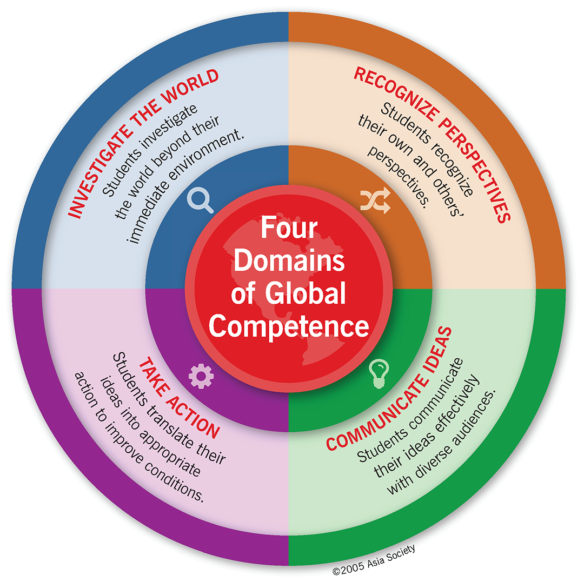The 2017 fall monarch butterfly migration is coming to a close. The butterflies soon will arrive by the thousands to oyamel fir trees that cover the mountains west of Mexico City. These amazing insects were my first introduction to including global competencies in my science classroom.
The monarch migration is an amazing phenomenon that grounds the teaching of several crosscutting concepts, including patterns and scale, proportion and quantity. Disciplinary core ideas LS2:A and LS2:C are also hit by the monarch population. These disciplinary core ideas discuss the role of the ecosystem on population size and factors that could affect it.
The Journey North, a citizen science program that focuses on the monarch migration, creates a symbolic migration that links Kentucky and Mexican students. Last year, my students crafted paper monarchs that were sent to schools bordering the monarch wintering sites. Mexican students created their own paper monarchs that were sent back to American classroom in the spring, which completed the migration.
When I discovered this program, I knew it also would be a great fit for the foreign language department. They participated in the virtual migration as a part of their Hispanic Heritage Month celebrations. We sent the paper monarchs with a care package that included a letter about us. Science students that also were enrolled in Spanish at the time translated the letter into Spanish (with the help of their Spanish teachers).
The science students received a deeper appreciation of the culture surrounding the ecosystem they were studying, and the Spanish students were able to understand some of the lore and myths surrounding the arrival of the mariposas (butterfly, in Spanish). The migration usually occurs around El Dia de los Muertos (or the Day of the Dead). The resources that my foreign language department provided about these traditions were invaluable and gave me great ideas about how to continue globalizing science curriculum.
The monarch migration creates a clear connection for including global competency in science instruction. However, a deeper look at the Domains of Global Competency and the Kentucky Academic Standards for Science show how with a slight shift in instruction, science students can be prepared to enter a global economy.
Since 2013, educators have been shifting and adapting instruction to integrate the three-dimensional nature of the Next Generation Science Standards – the science and engineering principles (SEP), the disciplinary core ideas and crosscutting concepts. A quick look at the SEPs and the four pillars of global competency show overlapping content. How can you ask questions about phenomena without investigating the world and culture surrounding it? A key point of analyzing and interpreting data is making sure you recognize the perspectives in which the data is housed.
 For example, agriculture data coming from India will look a lot different than that coming from Texas. A look into India’s religious context would provide insight on why there is no cattle or beef production. Communicating information is a key component in both models, and I would say those students who are able to communicate their solutions with a global perspective will be better prepared for success in our ever changing global workforce.
For example, agriculture data coming from India will look a lot different than that coming from Texas. A look into India’s religious context would provide insight on why there is no cattle or beef production. Communicating information is a key component in both models, and I would say those students who are able to communicate their solutions with a global perspective will be better prepared for success in our ever changing global workforce.
A Category 4 hurricane – Maria – hit Puerto Rico on Sept. 20, causing 30 inches of rain to fall on one day and knocking out power to the entire island. This natural disaster provides an example of how to imbed these competencies in three-dimensional instruction. An article from The Associated Press titled “Puerto Rico Struggles with massive environmental crisis” lets students engage in the dual nature of this real-world problem.
- What questions might they have about the problem itself and is this crisis different because of the location?
- Does their perspective as a Kentucky native change how they would design a solution to the Puerto Rico water problem?
- As they go to communicate their solutions, are they keeping their diverse audience in mind?
- How might they carry out their solution and take action to improve living conditions in Puerto Rico?
As science teachers continue to develop rich, three-dimensional tasks, keep in mind the global competence domains. This lens provides great depth for real-world scenarios and unit-driving phenomena.
For more information surrounding embedding global competencies in your discipline, including a checklist (page 71) and a matrix for teaching global competence in science (page 106), check out the publication by the Council of Chief State School Officers and the Asia Society: “Educating for Global Competence: Preparing Our Youth to Engage the World.”
Carly Baldwin, who is National Board certified, is currently serving as an effectiveness coach for the Kentucky Department of Education. Baldwin is highly involved in developing teacher leadership, as demonstrated by her involvement in Hope Street Group, Elevating and Celebrating Effective Teachers and Teaching (ECET2) and Classroom Teachers Enacting Positive Solutions (CTEPS). She earned a bachelor’s in biology from Murray State University and a master’s in education from the University of Tennessee at Martin.




Leave A Comment